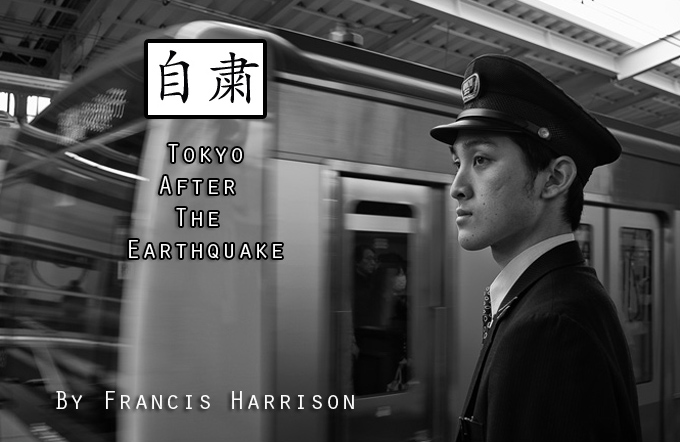
自粛 ”JISHUKU”: Tokyo after the earthquake
A photo essay
By Francis Harrison
“Jishuku” (自粛) refers to the general mood of self-restraint and self-denial which permeated Tokyo in the weeks that followed the Great East Japan Earthquake & Tsunami of March 11. Overnight all TV commercials were pulled, to be replaced by monochromatic public messages about breast cancer testing, helping old ladies across the road and fervent “Japan will rise again!” messages from pop idols and other personalities.
An Odakyu Railway guard strikes a stoic pose during morning rush hour. Devotion to duty is key to understanding the kind of everyday heroism on display by ordinary Japanese during these dark days.
–
Within five days 100,000 expats had fled the capital urged on by panicked messages from the embassies of France, China, the UK, India and finally the USA as well. This was the greatest exodus of gaijin since World War II. In just a few days, Tokyo went from a cosmopolitan metropolis to a provincial Japanese town.
What drove the panic of course was fear of radiation from the unfolding disaster at the Fukushima nuclear plant. In those first few weeks, no one knew for sure whether we were safe or not…
It rained hard the day before and we were told that radiation levels had doubled, carried by the rain.
–
Power outages also resulted from the nuclear fiasco up North. To avoid blackouts companies started turning off lights in offices during the day, plunging workers in near darkness at times. (It was also a way to save pennies…)
At my office in the Ginza, we work by the lights of our PC screen, squinting whenever we have to read a printed page.
As “Jishuku” gathered momentum, folks started to feel guilty about enjoying themselves or being seen to have a good time. By respect for the atrocious suffering of their fellow citizens in Tohoku, they avoided restaurants and bars, resulting in a severe strain on an already stressed economy.
A chef meticulously prepares a window display in an empty fish restaurant in the Ginza.
–
The loneliest bar in the world. (Yurakucho).
–
The bars and casual restaurants under the railway tracks in Yurakucho are usually bursting with happy customers.
–
A masked punter walks by a basement night club in Yurakucho.
–
For a brief spell the regular preoccupations of the city’s youth seemed to go by the board and it looked like nothing would be quite the same again.
Young ladies drift past a no longer relevant billboard advertising a once popular fashion brand in Shinjuku.
–
The ultimate challenge to the gathering gloom of “Jishuku” was the looming sakura season. Traditionally “Hanami” or “sakura viewing parties” are a sacred rite in land of traditions. This year many debated whether it was even proper to celebrate those pink blossoms while so many thousands had died up North or were living without electricity in homeless shelters.
Shy cherry blossoms make a first appearance by the railway tracks in Yurakucho. The sakura were late this year as if they too observed some form of “Jishuku”.
–
[ad#Adsense Blog Sq Embed Image]

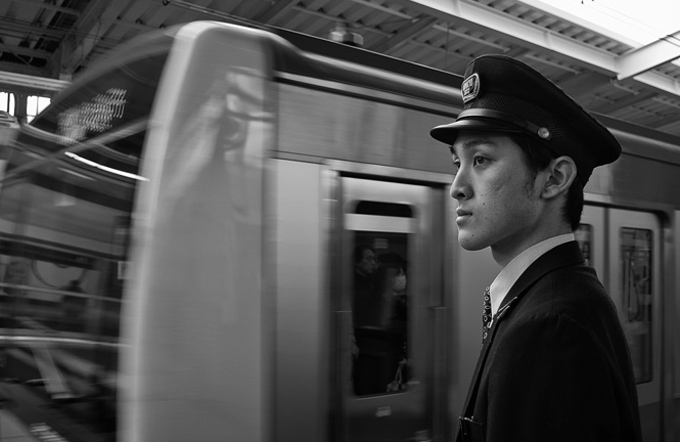
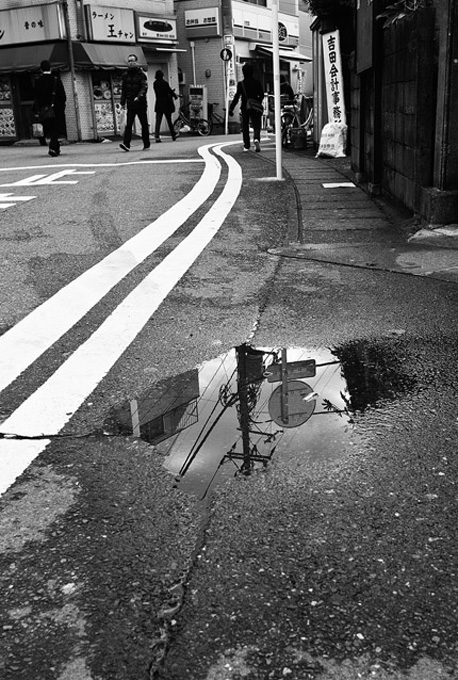
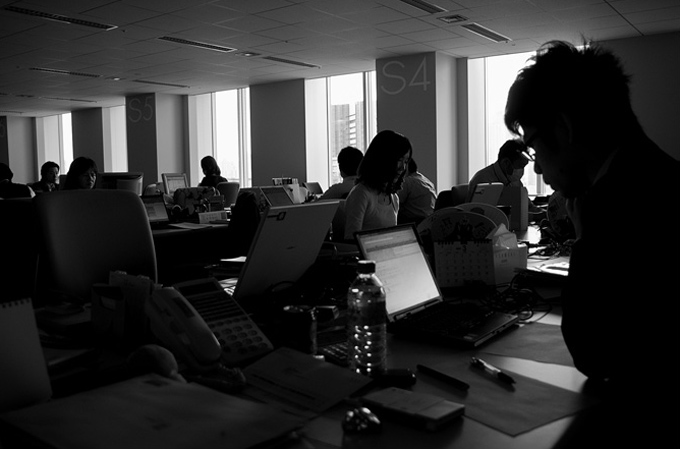
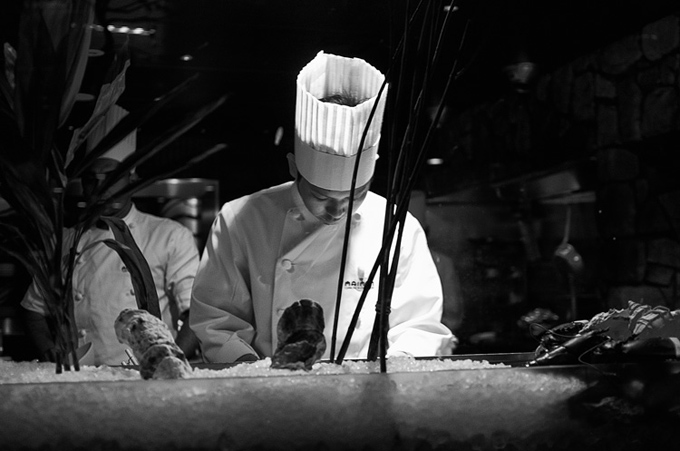
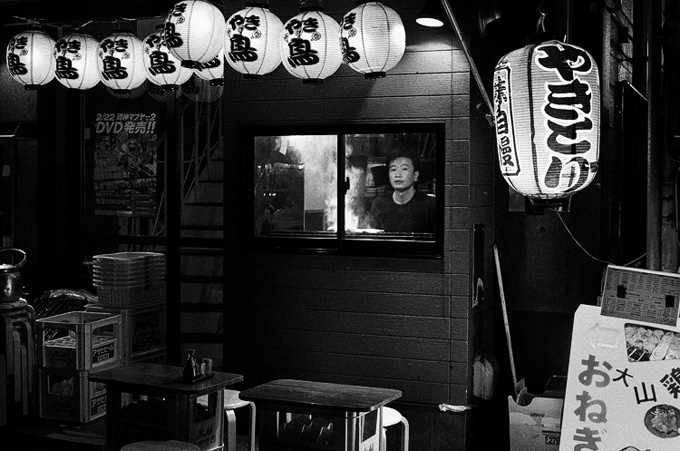
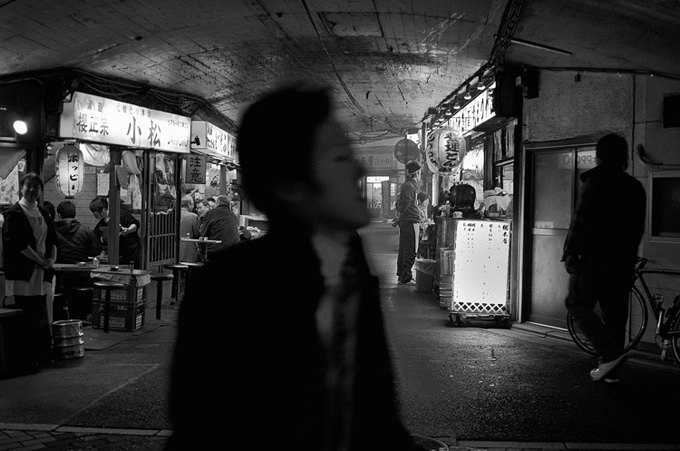
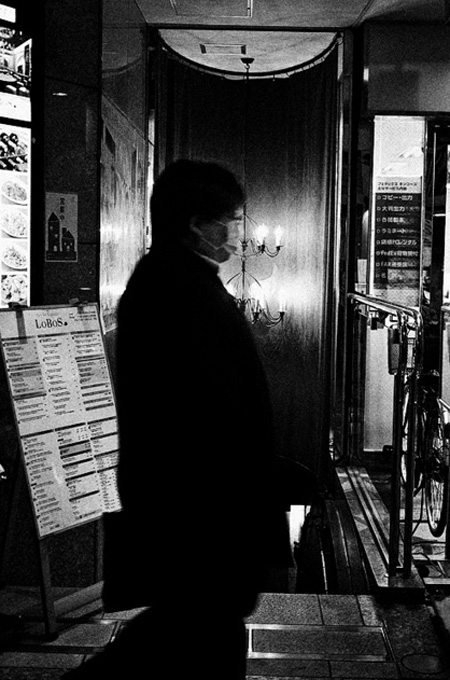
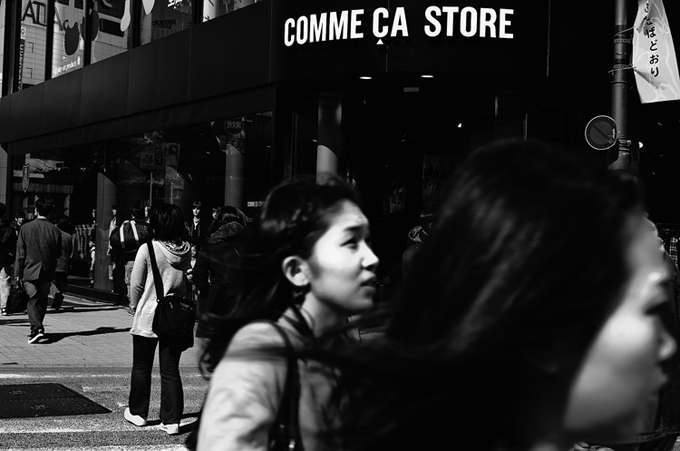
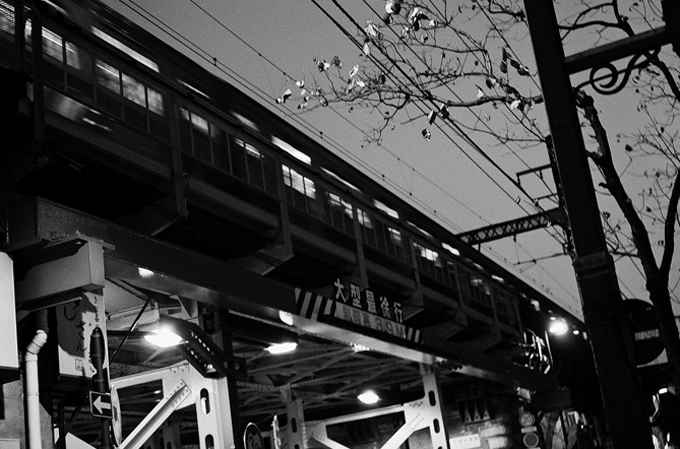
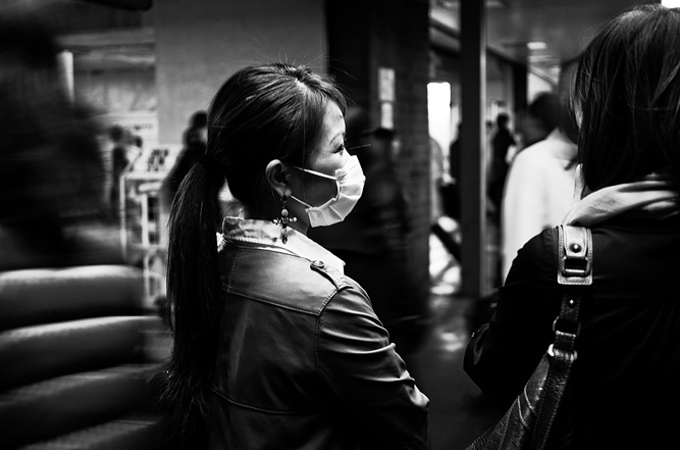

Thank you very much – I found your essay informative and moving
Hi Francis, I won’t dispute your sources or figures, they may well be correct but i sure didn’t see much evidence of a mass exodus. naturally there was an increase in numbers leaving because some were required to by their respective employers and some chose to, but I’m not convinced it was so many. I may be wrong and you may well be right. Statistics are always dubious depending on how they are obtained, calculated etc. i will say that in Japan statistics show that the birth rate is decreasing but. my goodness, look around in Japan and there seem to be more students and school kids than in any country i know.I can barely squeeze in the train or find a table at a family restaurant because of them.So i wonder.It must be true if the government is saying so but my eyes tell a different story.
Rather sad to think so many foreigners left. I chose to stay ( even though I am not married to a Japanese ) because i have lived here for 20 years and my life and friends are mostly all here now.
For those who have family in their respective countries it was understandable that they might want to return.Sometimes it’s a difficult choice either way.
I DO think your photos represent well YOUR interpretation of the situation as you have said in your comments… and they are nicely done.
Keep shooting!
Nice monochrome images…though these pictures don’t really tell or illustrate the period after the earthquake in any specific way.Could have been taken at any time. Typical scenes I think.
Japanese regularly wear masks for example to ward off colds or prevent giving them to others or because many suffer from Kafunsho ( Hay fever ) especially at this time of year, cherry blossoms are sometimes late or early as the case may be, and while it is true that less people were shopping, there were still lots of people out buying luxury items in the big department stores just days after the earthquake. I was there in Ginza right in the center of Tokyo.
most foreigners living here have adopted something of the sense of Japanese ” jishuku ” and opted to STAY in Japan. I00,000 expats left? really? Where did you get this figure? Sorry, as someone who lives here i doubt that number is accurate. Even inside the affected area where the Tsunami struck and the nuclear radiation leaks were most dangerous a great many foreigners chose to stay. Some did leave but in no way was it a huge exodus.
The mood changed for sure but in fact it was quite remarkable how life continued fairly normally for those living in the Tokyo area except for the panic buying of foodstuffs. This would have been a more interesting and telling focus of your photo essay.
Just my thoughts.
The pictures themselves are nice enough.
Steve,
It seems like my figures were conservative. Here are the figures extracted from the Ministry of Justice (via Kyodo News):
TOKYO, April 15 (AP) – (Kyodo)—A total of 531,000 foreigners left Japan in the four weeks from March 12 to April 8, including 244,000 in the first week after the March 11 earthquake and tsunami, the Justice Ministry said Friday.
The number of foreigners who left Japan in the first week after the disaster increased sharply from the 140,000 who left in the week before the calamity, reflecting the recommendations of their home country governments, the ministry said.
Of the foreigners who left Japan during the four weeks, 302,000, or almost 57 percent, obtained reentry permits.
The total included 185,000 Chinese, 107,000 South Koreans and 39,000 Americans.
I am not making this up.
It might even be worth writing a proper book about this extraordinary exodus.
Of course some of us stayed (mostly married to Japanese women I would think), but huge numbers left.
As to my pictures not being specific to that special time, I respectfully beg to differ. The lights in my office are still off during the day making it hard to read anything on cloudy days and I simply could not have shot that scene otherwise. Ditto with the eerily empty restaurants and bars in the Ginza/Yurakucho area. Empty food shelves? Sure I shot some of those during panic buying, Didn’t find them too exciting though.
Lastly this is not a “journalistic” essay, more a personally rumination on Tokyo in a time of enforced Jishuku. People are of course free to like the work, or not.
I liked a lot your essay, reading and looking at your photos made me think and feel, and that is for me the best part of photography
Not shocking, not impressing, just….
Thank you for sharing,
great set and great narrations. thankfully my friends and family are safe but i really feel for all those who have died and lives who have been ruined.
Great article, Francis! Thank you.
Greg Shanta
Nowhere else but here, in this sensitively understated and yet ever so poignant, powerful portfolio have I really got a glimpse into what the triple disaster’s aftermath must have actually felt like. Your black and white shots are exquisite, Francis, hauntingly so, demonstrating not only the strong skills but also the character of the person behind the lens, of one who had chosen to stay the course… Tremendous work, Francis!
Francis:
In a nod to architect Louis Sullivan’s famous dictum “form follows function”, I would say that in some cases “artistic style follows purpose”. Perhaps this sociological state of affairs in Japan has given you the opportunity to discover your photographic calling?
You have made a terrific series of shots, made all the more poignant by the context of the images. I have many friends in Japan and your images have given me an insight that my Japanese colleagues have not been able to express to me verbally. Keep up the terrific work!
Levent
Good article and pictures, an interesting insight.
Some good photographs, some mediocre
the closer, pictures of the lady, alley with the darkened figure, etc, and the first photo of the guy on the train station, I think are strong shots, do more like these…I think the others are technically too busy, and I dont like them, they r not strong, mediocre, but the three i refer to are very good9I think) you have the ability, you showed it in the good ones,
Thank you one and all for your extremely kind and encouraging comments. After years of haphazard street shooting in Tokyo (and sometimes SE Asia), the Great East Japan Earthquake & Tsunami as it is officially known, provided me with a focus I had not known previously. Documenting and trying to make sense of the life around me also provided some relief from the constant stress and tension. I am of course profoundly grateful to Steve for his generous hospitality.
Great pix and story! Thanks.
God bless Japan, God bless us all.
Francis, first off may I say thank you for sharing with us not only images of extremely high quality but so movingly capturing the mood of a nation that is adjusting to a frightening new reality. Secondly, if you are not working as photojournalist then you have missed your calling! This really is some of the most evocative documentary photography I have seen this year. Finally, whilst the dignity, stoicism and dedication to duty has impressed everyone around the world greatly I hope people are able to take a moment or two to enjoy and celebrate the Sakura as these are the things that make life worth living.
I’ve gotten much better impression of the japanese culture under such unimaginable catastrophe. Thanks for the insight.
I am no stranger to Francis’ work but his portrayal here of the fragility of the human condition is so poignantly captured. Those deep blacks have an emotional as well as a pictorial resonance. A beautiful portfolio, a story beautifully told.
Sylvie,
J’ai du m’y prendre à plusieurs reprises … et finalement, j’aime ton commentaire.
Ernesto
Amazing set of photos, great storytelling. I loved your post.
je suis restée plongée dans l’histoire, parmi les passants, sur le quai de cette gare…, le temps de descendre… sur le bas de la page et de décrire ce que je ressens en cet instant précis: ” c’est surréaliste, émouvant, et effrayant”…très réussi!
Stunning!
Really nice set of street photos.
Great pictures and storytelling.